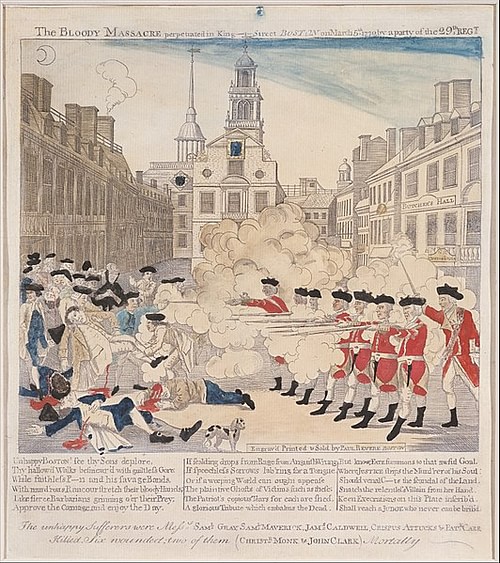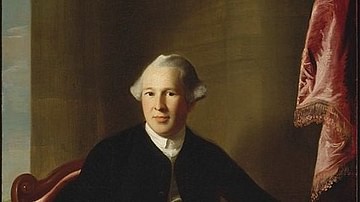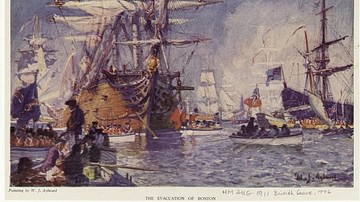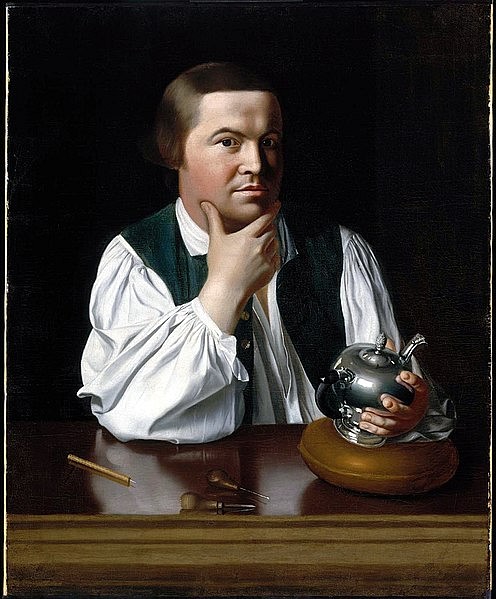
Paul Revere (1735-1818) was an American silversmith born in the British colony of Massachusetts. He was an active member of the Sons of Liberty during the American Revolution (c. 1765-1789) and became a folk hero for his midnight ride in 1775 when he warned the colonial militias of the approaching British troops before the Battles of Lexington and Concord.
Early Life
Paul Revere was born in the North End of Boston, capital of the British Province of Massachusetts Bay, on 1 or 2 January 1735; at the time of his birth, the Old Style calendar was still used in the British Empire, and as such, his birth was recorded as having occurred on 21 December 1734. His father had been born Apollos Rivoire, a French Huguenot who had immigrated to Boston in 1715 at the age of 13. Rivoire became apprenticed to a silversmith, a trade that he would one day pass on to his son, and in 1729, he married Deborah Hichborn, the daughter of a well-respected Boston family. At some point prior to his marriage to Deborah, Rivoire had anglicized his name to Paul Revere. Paul, Sr., and Deborah would have twelve children, of whom Paul, Jr., was their third, as well as their eldest surviving son.
As a boy, Paul Revere was educated at the North Writing School in Boston, where he became proficient in several skills, such as reading and writing; Revere developed his reading comprehension to the point of later being able to understand the difficult metallurgy books of his era. At the age of 13, he was pulled out of school and became his father's apprentice, and he spent most of his teenage years learning the art of a silversmith. The main purpose of a silversmith was to craft articles out of silver and gold, a task at which the energetic Revere quickly excelled.
In 1754, Revere was 19 and only a few years away from the end of his apprenticeship when his father died. He was too young to legally take control of his father's silver shop, which was a problem since Revere needed a source of income to provide for his mother and siblings. This need for money led Revere to enlist as a second lieutenant in the Massachusetts militia in 1756; the French and Indian War (1754-1763) was quickly escalating in North America, and army service could provide Revere with consistent pay. He was stationed at Fort William Henry on Lake George in the Province of New York, where he spent the summer of 1756. He did not see any action, however, and he was back in Boston by winter; at 21, he was now old enough to assume ownership of his father's shop, which he swiftly did.
On 4 August 1757, Revere married 21-year-old Sarah Orne. The couple would go on to have eight children before Sarah's premature death in May 1773. Revere married his second wife, Rachel Walker, six months later; Paul and Rachel would go on to have eight children of their own, whom Rachel cared for alongside the six surviving children from her husband's first marriage.
Revolutionary Activity
As the French and Indian War began to wind down, the British economy entered a recession and businesses like Revere's began to struggle financially. Revere had joined the Masonic Lodge of St. Andrew in 1760, the connections from which had brought him many new customers, but this was not enough to make ends meet for his quickly growing family. He began learning new skills and taking part-time jobs that would soon see him develop into something of a jack-of-all-trades. He crafted shoe buckles, teapots, and sugar bowls, made surgical tools, and sold spectacles. Between 1768 and 1775, he worked as a dentist, with his duties including cleaning teeth, replacing missing teeth, and selling toothpaste; despite popular belief, he did not make George Washington's set of dentures. Revere also found work as a copperplate engraver, with one of his most famous works being a depiction of the Boston Massacre in 1770.
Yet despite his many skills and his rapidly growing reputation as one of Boston's finest master craftsmen, times were still hard for Revere, as they were for many of his fellow colonists. This was one reason why Boston was so enraged when it learned of the Stamp Act, passed by British Parliament in March 1765. Hoping to pay off the staggering debt it had incurred fighting the French and Indian War, Parliament had decided to tax all paper documents in Britain's thirteen North American colonies; represented by a stamp, the tax was placed on newspapers, calendars, almanacs, and playing cards, as well as legal documents including contracts, marriage certificates, and liquor licenses. While Revere and many of his countrymen initially opposed the act for the additional strain it put on their purses, colonial agitators like Samuel Adams soon gave them another reason to resist it. Adams argued that any attempt by Parliament to directly tax the colonies violated their constitutional right to self-taxation since no Americans were represented in Parliament. This 'taxation without representation' was, according to Adams, tantamount to tributary slavery.
Revere was exposed to these ideas through his masonic friends, many of whom, such as Dr. Joseph Warren, would become leaders of Massachusetts' Patriot movement. By the late 1760s, Revere was a committed Patriot and an associate of the underground political organization known as the Sons of Liberty. Revere was considered a valuable link between the Revolution's intellectual leaders like Samuel Adams and John Hancock and the artisans and other working people of Boston. He aided the cause by making anti-British political cartoons and engravings. In 1770, he purchased a house on North Square in Boston's North End to support his enlarged family and became a member of the informal North End Caucus, which directed political activity in that part of the town.
In November 1773, a ship carrying British East India Company tea, the Dartmouth, entered Boston Harbor. Parliament had recently passed the Tea Act, which had granted the East India Company a monopoly on the American tea trade; this act was opposed by the American Patriots since the East India Company tea carried a Parliamentary tax. With Samuel Adams emphasizing that the tea could under no circumstances be allowed to be sold, Revere and Dr. Warren organized a guard to stand watch and ensure that the tea did not leave the cargo hold of the Dartmouth. On 16 December 1773, Revere was part of a group of 30-130 Sons of Liberty who disguised themselves as Mohawk Native Americans, boarded the Dartmouth and two other vessels, and dumped 342 crates of East India Company tea into Boston Harbor. The next day, Revere set out for New York City and Philadelphia to spread the word of this protest, known as the Boston Tea Party; this was the start of his informal position as 'messenger of the American Revolution'. He served in a messenger capacity during the First Continental Congress in September and October 1774, delivering messages between Massachusetts and the Congress in Philadelphia.
Midnight Ride
When Parliament learned of the Boston Tea Party, it sought to make an example out of rebellious Boston and passed a series of policies that were soon to be known in the colonies as the 'Intolerable Acts'; these included the closure of Boston's port to commerce, the installation of a military governor in Massachusetts, and the replacement of several public officials with royal appointees. In Massachusetts, political unrest skyrocketed; local militias began preparing for war with the British soldiers, while in October 1774, Massachusetts leaders formed the Provincial Congress as an American provisional government to counterbalance the British military government. During this time, Revere and several other artisans began gathering intelligence on the British officers in Boston and would meet in a tavern called the Green Dragon to discuss their findings.
On 16 April 1775, Revere was summoned by his friend Dr. Joseph Warren. Warren explained that the British soldiers seemed to be preparing for an expedition to the town of Concord to seize the gunpowder stored there; along the route to Concord was the town of Lexington, where revolutionary leaders Samuel Adams and John Hancock were hiding, and Warren was concerned that the soldiers may be seeking to arrest them as well. Warren dispatched Revere to Lexington to warn Adams and Hancock. On his way back to Boston, Revere stopped by Charlestown, just to the north of Boston, to arrange a signal for when the British actually did begin to march: one lantern was to be hung from the steeple of the North Church if the British made their way over land, and two lanterns were to be hung if the British came by boat across the Charles River. Today, American schoolchildren memorize this famous signal by the phrase 'one if by land, two if by sea'.
On the night of 18 April, Revere received word from Dr. Warren that the British expedition was setting out in only a few hours. Revere took one of the two main roads to Concord, passing through the modern-day towns of Somerville, Medford, and Arlington to alert the local militias that 'the regulars are coming out'; another man, William Dawes, was sent down the other road bearing the same message. Revere evaded capture by a pair of British officers before once again arriving in Lexington, close to midnight. As he neared the house where Hancock and Adams were sleeping, Revere was reprimanded by a local militiaman for making too much noise. “Noise!” Revere responded. “You'll have noise enough before long! The regulars are coming out” (Philbrick, 238).

Hancock and Adams were then woken up and, after conferring with Revere, decided to flee for their own safeties while the town's militiamen began assembling on Lexington Green to confront the British. Revere, Dawes, and a third man named Dr. Samuel Prescott then continued on the road to Concord. Along the way, Revere was captured by another group of British officers, although Dawes and Prescott were able to finish the route. Despite being held at gunpoint and forced to dismount, Revere was ultimately released by the officers. He made his way back to Lexington on foot, arriving in time to witness the standoff between the militiamen and British regulars that sparked the Battles of Lexington and Concord. Revere helped carry off a trunk of Hancock's papers as the crackle of musket fire erupted on Lexington Green that would leave eight colonists dead and ten wounded. Paul Revere's midnight ride was over; but, especially after it was immortalized in Henry Wadsworth Longfellow's 1861 poem “Paul Revere's Ride”, it had cemented his role as an American folk hero.
Revolutionary War
After moving through Lexington, the British continued on to Concord but were frustrated to find that the Americans had hidden most of the military supplies. During their subsequent retreat to Boston, the soldiers were fired upon by a steadily growing number of colonial militiamen. By the next morning, 15,000 militiamen from the New England colonies had surrounded Boston and began to lay siege. Since the siege prevented him from returning to Boston, Revere rented a room in nearby Watertown, where he was eventually joined by his wife and children. Although he was denied a commission in the newly formed Continental Army, he was dispatched by the Provincial Congress to Philadelphia to study the only working gunpowder mill in the colonies, in the hopes that a second one could be built in Massachusetts. Revere uncovered enough information for a mill to be constructed in present-day Canton, Massachusetts.
In March 1776, the Siege of Boston ended in an American victory. In its aftermath, Revere identified the mangled corpse of his friend, Dr. Warren, who had been killed at the Battle of Bunker Hill (17 June 1775). Revere mourned the loss of his friend and, when his next son was born in 1777, he named him Joseph Warren Revere in the doctor's honor. Looking for additional ways to serve the Revolution, Revere was appointed a lieutenant colonel in the artillery of the Massachusetts militia. In June 1779, he was given command of the artillery in a multicolony expedition to the Maine district of Massachusetts (modern state of Maine) to seize a British fort at the mouth of the Penobscot River. The Penobscot Expedition got off to a rough start, however, as its land and naval commanders quarreled with one another. Upon arriving in Penobscot Bay, the American forces were trapped by a squadron of British ships; as the British began firing on the American vessels, the Americans scattered and ran back down the Penobscot River in a disorderly retreat.
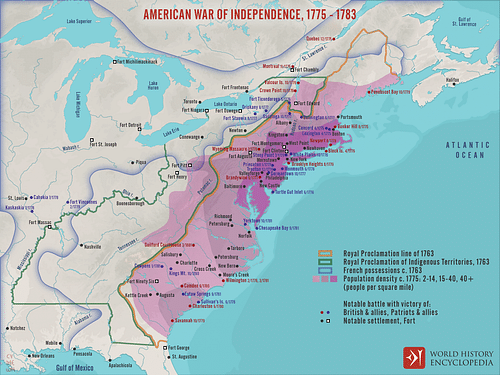
Revere was accused of cowardice and insubordination and was largely blamed for the failure of the expedition. This outraged Revere, who demanded to be court-martialed so he could clear his name of any wrongdoing; Revere finally received a court-martial in February 1782, which exonerated him. Although the accusations had already killed his military career, Revere believed that the court-martial's findings had restored his honor and was satisfied. He returned to Boston to resume his life as a silversmith. In 1783, the American Revolutionary War came to an end, and the United States of America was finally independent.
Later Years
In the decades after the Revolutionary War, Revere became a prosperous businessman and a respected citizen of Boston. Turning the day-to-day operations of his silver shop over to his son, Paul, Jr., Revere opened a hardware store in downtown Boston; by 1788, his enterprises were successful enough to allow him to open a third business, a foundry, from which he sold bolts, spikes, and nails to shipyards. The brass fittings for the famous naval vessel, USS Constitution, were supplied from Revere's foundry. In 1801, Revere opened the first copper rolling mill in North America to avoid relying on imports from England and supplied the copper for the dome of the Massachusetts State House in 1802. When the USS Constitution needed new copper sheeting in 1803, Revere's mill provided that as well. Throughout this time, Revere remained active in politics; he supported the Federalist policies of Alexander Hamilton and John Adams in the 1790s and served as Grandmaster of the Massachusetts Freemasons from 1795 to 1797.
Revere retired from his businesses in 1811 at the age of 76, handing his prosperous copper mill over to his son John Warren Revere. The copper business continues to survive today as the Revere Copper Company. In 1813, he suffered the losses of both his wife Rachel and his son Paul, Jr. Revere remained in good health himself until his death of natural causes on 10 May 1818 at the age of 83. His memory endures in American culture as one of the most iconic figures of the Revolution, whose famous midnight ride helped lead to the birth of the United States of America.

